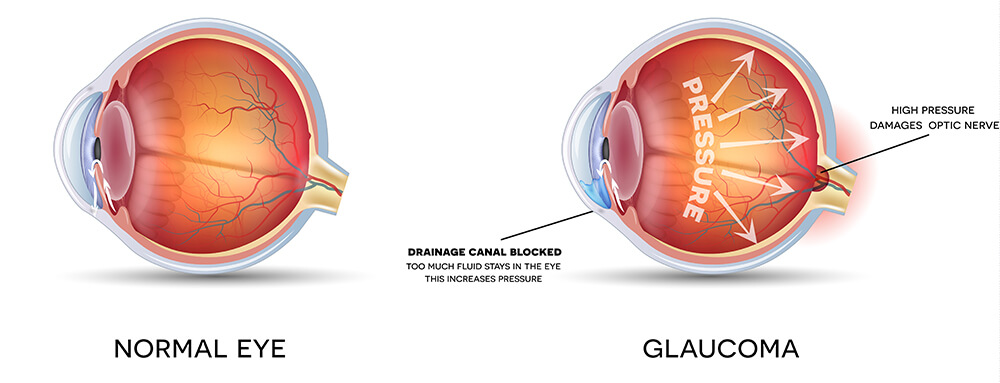Home » Glaucoma
Glaucoma
The possibility of having glaucoma can be quite frightening because we all know of people who have lost some or all of their vision due to the disease. Actually, glaucoma is quite treatable and something can almost always be done to prevent further loss of vision. It is the people who don’t get checked or who know they may have a problem and ignore it who usually get into trouble.
All eyes have some pressure to keep them “inflated” and seeing properly. Normal ocular pressure ranges from around 10 to 20 units. Ocular pressure is considered high when it is over 21. The weakest part of the eye is the surface of the optic nerve. Normally the surface of the nerve is almost flat, but if there is too much pressure within the eye, the flat surface of the nerve develops a dimple-like bulge. This is due to nerve fiber damage. As this dimple, or so-called optic disc cup, gets larger with prolonged pressure elevation, one’s peripheral vision gradually becomes impaired.
There is usually no precise moment when the diagnosis of glaucoma can be made. There may be a suspicion early on that somebody might develop glaucoma, but the person may have no evidence of damage to their eyes for quite some time. Rather than start medications when there is no clear-cut need, patients are told that glaucoma may be developing and that they should be monitored more frequently than the usual annual or biannual check.
In general, the diagnosis of glaucoma is not made until three factors are present: increased intraocular pressure, optic nerve damage, and some loss of vision. There are some people, however, who have high pressures but no damage to their optic nerves or loss of vision. These people are considered ocular hypertensives or glaucoma suspects. Some of these individuals will never develop glaucoma, but many probably will.
Approximately one to four percent of ocular hypertensives develop glaucoma each year; this percentage is even higher for patients with very high pressures. For instance, about five percent of all people with pressures above 21 will develop glaucoma in their lifetime, but 10 percent of those with pressures over 24 will eventually develop glaucoma. When pressure reaches about 30 units, the chance is close to 100 percent.
It is important to remember, however, that pressure and how it relates to vision damage varies from person to person. There are no circumstances in which glaucoma will always occur or, conversely, will definitely not occur. That is one reason why glaucoma is difficult to diagnose.
We do know that the chance for developing glaucoma gets higher when there are other risk factors involved in addition to high pressure. High-risk suspects have one or more of the following factors:
- pressure that is repeatedly in the mid- to upper-20s
- over 50 years of age
- African-American descent
- family history of glaucoma
- abnormal optic nerve appearance
- a high degree of nearsightedness (myopia)
- systemic problems like cardiovascular disease, diabetes, migraines and high blood pressure
To prevent vision damage, high-risk suspects are often treated similarly to patients with glaucoma. This normally involves lowering their eye pressures with medicine, and perhaps having surgery. The goal is to control pressure or bring it down to levels where damage is less likely to occur.
If you are a glaucoma suspect, the best way to prevent damage from glaucoma is to get frequent follow-up exams. At these exams, the pressure in your eyes and the appearance of your optic nerves will be assessed. Periodically, we will also check your visual fields with a special instrument that helps us to make sure you are not developing any loss of your peripheral vision.
The important point to remember is that even if the diagnosis of glaucoma cannot be made with certainty at this time, you cannot ignore the possibility and assume that vision damage will never occur. Most glaucoma patients were, at some point, glaucoma suspects.
Normal Tension Glaucoma
Although glaucoma is usually characterized by high intraocular pressure, optic nerve damage and loss of vision, one form of glaucoma does not fit this picture. This is the so-called “low-tension” glaucoma. This type of glaucoma causes optic nerve damage and vision loss, even though intraocular pressures are normal or sometimes even less than normal.
There are many theories for why this may happen. Some say that there are actually periods of high pressure, called spikes, that occur while patients are sleeping and so they go undetected. Others say that high pressure is never present in these patients, and the cause of the damage is from another unknown source, such as poor blood circulation in the optic nerve. We do know that some of the same glaucoma risk factors apply to low-tension glaucoma, such as migraine headaches, family history of glaucoma, nearsightedness and, in particular, age.
This disease is sometimes difficult to treat, mainly because all glaucoma medications are geared to lowering higher than normal pressures and these patients already have normal or even low pressures. However, there are various medications, laser treatments and surgical operations which can help to prevent further nerve damage.








